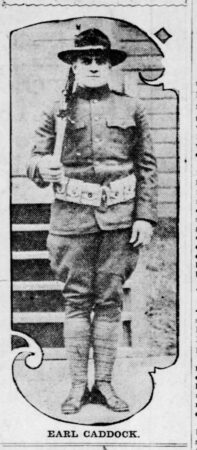Caddock thiab W. Zbyszko Wrestle kos
Earl Caddock muaj ib tug kuj luv luv tab sis storied kev wrestling hauj lwm hauv lub caij 1910s lig thiab thaum ntxov 1920s thaum ntxov. Ua nws debut debut hauv 1915 Tom qab winning peb AAU lub teb chaws lub npe hauv amateur wrestling, Caddock tsuas wrestled professionally mus txog rau thaum 1922. Txawm li cas los, Nws yuav pom tau hais tias raws li ntiaj teb tau zus ib tom qab defeating Joe Stecher nyob rau lub plaub hlis 1917. Caddock would lose the title back to Stecher in 1920. The rematch was delayed by Caddock’s Army service during World War I, when he saw fighting in France.

World Heavyweight Wrestling Champion Earl Caddock from the Public Domain
Prior to leaving for France, Caddock defended his title against Wladek Zbyszko on Friday, Lub ob hlis ntuj 8, 1918 in front of several thousand soldiers in Fort Dodge, Iowa. Caddock was billeted near this town preparing to ship out overseas. The match was scheduled for 2 tawm ntawm 3 falls with a 2 teev, 30 minutes time-limit.
Caddock and Zbyszko engaged in a long, gruelling match for the soldiers. Caddock was the clear favorite of his fellow soldiers but there was no nationalistic antagonism towards Zbyszko.
Cov txiv neej wrestled rau 1 teev, 20 minutes before Earl Caddock secured a wristlock and head scissors to score the first fall. Both men were breathing heavily as the 15-minute rest period between falls began.
The second fall began and continued for another 31 minutes of exhaustive, defensive wrestling until Zbyszko was able to pull Caddock into a side hip lock.
Zbyszko threw himself backwards landing all 226-pounds of his bodyweight on top of a Caddock. The 185-pound Caddock was pinned for the second fall. It took Caddock’s corner several minutes to bring Caddock back to his feet and revive him for the final fall.
Caddock primarily stayed away from Zbyszko for the next 37 feeb. The match ended at the curfew of 1:15 a.m. Ed Smith, the referee for most of the world title matches since the first Gotch-Hackenschmidt match in 1908, declared Caddock the winner on points even though both men had scored a fall. Nquag, the match would be considered a draw.

World Champion Earl Caddock in military uniform from the February 9, 1918 ib tsab ntawm tus me nyuam. Louis Dispatch tom qab (Public sau)
The lack of a title switch in this match is interesting. We are well into the “ua haujlwm” era by this time. I have no evidence that this match was anything other than a prearranged exhibition. Tsis tau, Caddock is heading out of the country for an undetermined period of time and the promoters left the world championship on Caddock.
Since Zbyszko wasn’t going anywhere, it would make sense to drop the belt to him. When Caddock returned, he could beat Zbyszko for the title setting up the Stecher-Caddock rematch. Txawm li cas los, the promoters must have wanted to keep Caddock undefeated and trust that he would be back soon to have what must have been a big money match with Stecher.
It may also have been a realization that with America entering World War I, entertainment like sporting events may be curtailed for a few years. Whatever their reason, the promoters didn’t switch the belt to Zbyszko.
After distinguished service in France, Earl Caddock did return to the United States and back to the wrestling ring. He would meet Joe Stecher in a rematch during early 1920 but that is a story for another post.
Koj yuav tawm ib saib los nug cov lus nug txog qhov no los yog tej tsev xa rau kuv Facebook phab.
Qhov chaw: St. Louis Dispatch tom qab, Lub ob hlis ntuj 9, 1918 ib tsab, p. 8 thiab Earl Caddock’s National Wrestling Hall of Fame page
Pin It
